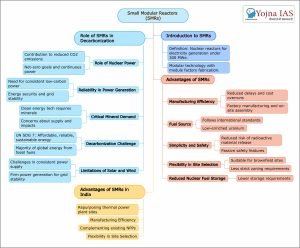11 Aug 2023 Small Modular Reactors (SMRs)
This article covers “Daily Current Affairs” and the topic details “Small Modular Reactors (SMRs)”. The topic “Small Modular Reactors (SMRs)” has relevance in the “Science and Technology” section of the UPSC CSE exam.
For Prelims:
What are Small Modular Reactors (SMRs)?
For Mains:
GS3: Science and Technology: Developments and applications
Why in the news?
Recently, there has been a debate among the various stakeholders i.e , can Small Modular Reactors (SMRs) help India in achieving sustainable energy production
Small Modular Reactors (SMRs)
- Small Modular Reactors (SMRs) are nuclear reactors designed for electricity generation that have a capacity generally under 300 MWe, with modular technology utilizing module factory fabrication.
- They aim to achieve economies of series production and shorter construction times compared to larger conventional nuclear power plants.
- The International Atomic Energy Agency (IAEA) considers reactors under 300 MWe as “small” and up to about 700 MWe as “medium.” These reactors collectively fall under the category of SMRs
- However, in common usage, “SMR” often stands for “small modular reactor,” which is designed for serial construction and to constitute a larger nuclear power plant.
- A category of smaller reactors known as vSMRs, which stands for very small modular reactors, is being considered for deployment in units with capacities of around 15 MWe. These vSMRs are particularly well-suited for remote communities.
The Need for Small Modular Reactors (SMRs) in Decarbonization
- Decarbonization Challenge: UN Sustainable Development Goal 7 prioritizes making affordable, dependable, and sustainable energy accessible to everyone.Despite progress, 82% of global energy still comes from fossil fuels. Electrification will increase 80%-150% by 2050, making reliable low-carbon electricity crucial.
- Reliability in Power Generation: Recent coal consumption growth in Europe highlights the need for consistent 24/7 low-carbon power, ensuring stable grids and energy security alongside deep decarbonization efforts.
- Limitations of Solar and Wind: Relying solely on solar and wind energy poses challenges for consistent power supply. Additional firm power generation technologies are necessary to enhance grid stability and reduce costs in decarbonized energy systems.
- Critical Mineral Demand: Clean energy technologies require critical minerals like lithium, nickel, cobalt, and rare earth elements. Their demand could triple by 2030, leading to concerns about capital investments, environmental impacts, and geopolitical risks related to mineral extraction and processing.
- Role of Nuclear Power: Nuclear power supplies 10% of global electricity, contributing to reduced natural gas demand and CO2 emissions. Its role is vital in achieving net-zero goals, offering continuous power generation and various co-benefits like high-skill jobs.
- Advantages of SMRs: While conventional nuclear power plants face challenges like time and cost overruns, SMRs offer a solution. With a capacity of up to 300 MW, SMRs can complement existing NPPs and be located in repurposed thermal power plant sites, avoiding land acquisition and displacement issues. This is particularly relevant for India’s energy needs.
Advantages of SMRs:
- Simplicity and Safety: SMR designs are simpler and include passive safety features, reducing the risk of uncontrolled radioactive material release.
- Reduced Nuclear Fuel Storage: SMRs store less spent nuclear fuel compared to conventional NPPs.
- Flexibility in Site Selection: They can be installed at brownfield sites with less strict zoning requirements.
- Fuel Source: Most land-based SMRs use low-enriched uranium, which is widely available from uranium-mining countries following international standards.
- Manufacturing Efficiency: SMRs are manufactured in factories and assembled on-site, leading to lower potential for delays and cost overruns.
Required Legal and Regulatory Adjustments
- To enable private sector participation in SMRs, amendments to the Atomic Energy Act are essential.
- While empowering the private sector, control over nuclear fuel and waste management should remain with the government.
- Establishing an independent regulatory body with expertise to oversee the entire nuclear power generation process is necessary.
- While government control over SMR security should persist, privately-owned SMRs can be managed by the Nuclear Power Corporation during the initial stages.
- The Department of Atomic Energy must enhance public confidence in nuclear power by effectively sharing comprehensive environmental and public health data related to civilian reactors operating under international safeguards in India.
As India seeks to expand its nuclear power capacity, SMRs present a strategic opportunity. By aligning regulatory adjustments, public engagement, and technological advancements, India can enhance its energy security, accelerate the transition to clean energy, and pave the way for a more sustainable and resilient energy future.

Sources: Can small modular nuclear reactors help India achieve net-zero? – The Hindu
Q1. With reference to Small Modular Reactors (SMRs), consider the following statements:
- SMRs are nuclear reactors designed for electricity generation with a capacity generally under 500 MW
- Nuclear power contributes around 10% of global electricity.
Which of the statements given above is/are correct?
(a) 1 only
(b) 2 only
(c) Both 1 and 2
(d) Neither 1 nor 2
Answer: C
Q2. Consider the following statements regarding
- SMRs are exclusively designed for remote communities.
- SMRs are always more complex in design compared to conventional nuclear power plants.
Which of the statements given above is/are correct?
(a) 1 only
(b) 2 only
(c) Both 1 and 2
(d) Neither 1 nor 2
Answer: D
Q3.Discuss the role of nuclear energy in the context of environmental sustainability and the challenges associated with its integration into a clean energy transition.


No Comments